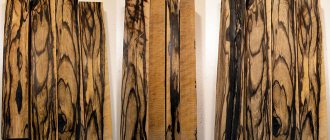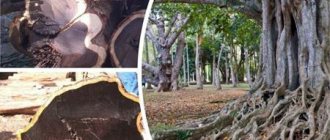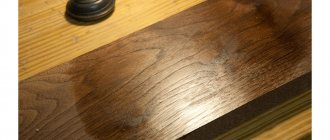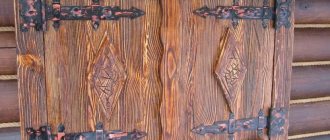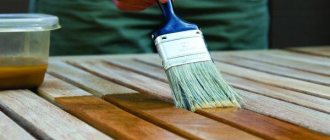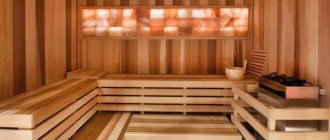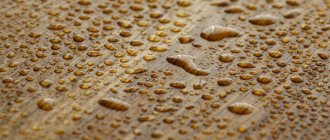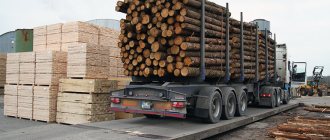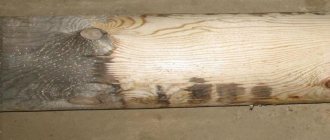Types of antiseptics
Modern means of protecting wood from rotting and moisture include a huge range of antiseptic compounds, which are divided into several groups.
The word antiseptic itself is a combination of two Greek words: “against” and “putrefactive.” The classification of antiseptic compositions is based on the features of their use. Based on the place of treatment (localization), a division is made into internal and external effects. For external use, antiseptic drugs are more effective, but almost all of them are toxic.
Based on the raw material, wood impregnations can be organic or inorganic. Inorganic antiseptics are less harmful because they are quickly absorbed into the wood after application. Today, all manufacturers of antiseptic compounds are trying to reduce the toxicity of the drugs they offer.
Impregnations are divided according to the nature of the solvent present in the composition. There are two positions here: aqueous solution and non-aqueous solution. The first is organic or synthetic salts diluted in water. This group is divided into two subgroups: surface antiseptics and penetrating ones. The second are mixtures that contain additional non-aqueous ingredients.
It should be noted that the proposed antiseptic compositions are often used in conjunction with other protective impregnations, for example, with water-repellent paints, drying oils or varnishes. Separately, it should be said about oil-based septic tanks. This is an excellent material for impregnating wood, highly effective and strengthening. Penetrating deep into the wood, it binds the fibers, as if they are preserved.
Manufacturers offer antiseptics in the form of powders, ready-made solutions and pastes. The first are ammonium or sodium fluorides, which upon contact with water turn into a clear liquid. It is easy to apply, dries quickly, and is odorless. It should be noted that an aqueous solution of sodium fluoride powder does not interact with metals. That is, by treating wood with such impregnation, you can be sure that metal fasteners or other parts of a metal structure will not corrode under the influence of liquid.
Antiseptic pastes are made on the basis of technical oils with the addition of water and silicon fluorides. It is believed that this is the most effective material in terms of protection against moisture, rot and microorganisms. But it, in turn, is the most toxic. Therefore, pastes are not used for internal treatment of wood trim or interior items. Most often they are used to process support pillars, fences, piles, supports for berths, etc.
Why does wood rot?
To effectively counteract wood decay, you need to understand the mechanism of this process. Rotting is caused by the activity of wood-decaying fungi. They are lower plants that are not able to convert minerals into organic substances, and are forced to parasitize wood.
The source of food for mushrooms is cellulose, the main component of wood, which is nothing more than carbohydrates. They cannot assimilate it in its pure form. To make their carbohydrate meal digestible, mushrooms secrete enzymes that convert cellulose into water-soluble glucose. This process is accompanied by the decomposition of the main structural components of wood with the release of carbon dioxide and water. Without going into details, this is the process of rotting, leading to the complete destruction of wood.
There are more than 60 species of fungi that attack wood. They differ in varying degrees of aggressiveness, but their development requires the same conditions.
- The moisture content of the wood itself is 20% or higher.
- Air temperature – from 5 to 30°C.
- Mandatory access to oxygen, which is involved in a chain of chemical processes.
Protecting wood from rotting and moisture
To prevent wood rotting, you need to act in two directions:
I. Eliminate favorable conditions for the development of wood-decaying fungi (use only dry lumber and do not neglect constructive measures to protect wood from moisture).
II. The second direction in the fight against decay is the mandatory treatment of wood with antiseptics, which protect the material from fungi and other agents of biodamage.
Mushrooms are the main detractors of wood in wildlife, but they are far from the only ones. Biological agents of destruction also include: insects, bacteria, algae, mollusks and crustaceans.
Features of log operation
Wooden structural elements during operation are not directly exposed to all kinds of natural factors, such as precipitation and wind. As a rule, there is no direct contact between the logs and the natural environment.
Sometimes dampness can damage them only if they are laid on a damp foundation. But when installing logs, property owners strive to prevent the beams from coming into contact with the external environment. In this case we are talking about the device of vapor and waterproofing.
Since wood is highly susceptible to rotting processes and mold fungi can intensively multiply on it, it must be protected from adverse external factors.
Types of carpentry production
According to the general classifier, the following types of woodworking-related industries are distinguished:
- Production of lumber with a thickness of 6 mm.
- Production of straw, cork and all kinds of weaving materials.
- Production of panel materials. Processing wood by mechanical means in this case is especially closely combined with chemical protective impregnation, which allows the fine structure to provide high wear resistance to the product.
- Production of materials for flooring - this group includes lamellas, parquet boards, logs, etc.
- Production of wood fiber, wood flour, wood chips, etc.
- Large format production. The work of such enterprises is associated with the production of beams, timber, boards and other structural elements that are used in the construction of load-bearing foundations of wooden buildings.
Processing rules
Processing boards with impregnation does not cause any particular difficulties. However, there are several rules that must be strictly followed to achieve the desired result and maintain your own health:
It is imperative to protect all vulnerable areas of the human body that will be in direct contact with the solution (hands: eyes, respiratory organs). Before processing wood to prevent it from rotting, it is necessary to prepare it for work: clean it of dust, grease or previously applied paint. The board is carefully processed using a brush with metal bristles. It is best to wash the surface using detergents. It is equally important to let the wood dry thoroughly. Before impregnating the wood, carefully read the instructions for its use on the packaging. It is recommended to start with the end parts of the board, cuts and areas that are already damaged. If there is a need to apply the product in several layers, it is necessary to allow time for the previous layer to dry completely. Typically this period of time is 2–3 hours.
A couple of antique wood recipes
You can find many recipes for aging wood using improvised means, but all of them are derivatives of the processing methods already described. Let's look at some of them.
Using wax
Using regular wax you can achieve a good effect; you only need 2 types of wax (colored and regular), as well as a wood sanding machine. This method is convenient because it does not require additional steps such as brushing the wood or using acid to remove soft parts of the wood.
You can buy any color of wax
The technology for doing the work will look like this:
- first the board is sanded, and the direction is strictly along the grain;
- then colored wax is applied; at the previous stage, the pores of the wood have opened, so it will penetrate well. It takes about a day for the coating to harden;
- Next, you will have to apply colorless wax on top of the colored one, and some of the colored wax will inevitably be removed.
An example of wood processing with colored wax
Bleached wood
Bleached wood will look unusual in any interior. It costs a lot, but you can achieve the same effect with your own hands when painting wood. The main task in this case is to ensure that the white color does not completely “clog” the texture of the wood; ideally, the wood should have a slightly grayish tint and the wood pattern should be visible through the layer of white paint.
Bleached wood
You can get the desired effect using brushing technology, and the key point will be how to paint an antique board so that the wood pattern remains noticeable after painting.
To do this, you can use tinted and transparent varnishes, and painting will be carried out in several stages:
- if the wood is dense and does not absorb varnish well, then you can immediately treat the prepared surface with tinted varnish in a couple of layers;
- then a clear varnish is applied over it to protect the tint.
Tinted varnish from a renowned manufacturer
The same effect can be achieved using white paint, but here you need to take into account that it is easy to paint over the wood pattern 100%. Therefore, after applying the paint, you can carefully blot it with a sponge so that the texture of the board becomes visible.
No. 8. Sequence of application of protective agents
To ensure maximum safety of the wood, it is treated with protective agents in the following sequence:
- antiseptics at the stage of procurement and transportation, as well as after the construction of the structure, furniture, organization of finishing;
- treatment with fire retardants if necessary;
- treatment with moisture-repellent impregnations, which will also prevent the leaching of fire retardant and antiseptic;
- applying paints and varnishes with ultraviolet protection;
- sealing joints and seams using acrylic sealant is an important process that prevents moisture from penetrating into the wood.
Top best products for external wood treatment
| Brand | Characteristic | Price |
| Senezh (Russia) | High-class, difficult-to-wash compounds in 20 types, including whitening and renewing compounds, antiseptics for baths, homes and gazebos; protect from fire, pests and moisture, provides protection for more than 10 years! | from 380 rubles (5kg) |
| Belinka (Slovenia) | Natural and safe, highly effective products that protect against ultraviolet radiation, moisture, insects and fire, a wide range of products | from 400 rubles (1l) |
| Pinotex (Estonia) | Polymer-based products protect against mold and moisture, fungus and insects, and withstand sudden temperature changes, therefore they are optimal for external treatment | from 280 rubles (1 l) |
| Neomid (Russia) | Effective impregnation for home, bathhouses and wooden floors, protects the surface from moisture for 5-7 years, they produce special products for treating the ends, a good price-quality ratio | from 200 rubles (1 l) |
| Tikkurila (Finland) | Moisture-resistant products, create a thin protective film and provide reliable protection from precipitation, are distinguished by high quality and positive reviews | from 250 rubles (1l) |
| Aquatex (Russia) | Available in the form of a primer and impregnation, colorless and tinted versions (15 colors), protects against fungus, ultraviolet radiation and moisture, suitable for middle-class wood | from 200 rubles (1 l) |
| Sitex (Russia) | Suitable for any type of wood, protects logs from moisture, preserves the appearance of the structure for 10 years, colorless and tinted options (12 colors) | from 200 rubles (1 l) |
Brushing
This method of aging wood with your own hands is called from the concept brush, which translates as brush. The second name is tree structuring.
The degree to which it needs to age is determined by its purpose. If necessary, to create the appearance of deep antiquity, cutouts are made up to 3 mm. For floor coverings, such aging is not suitable, since it will collect a lot of dirt, and it is difficult to wash it off. On average, a depth of about 0.7 mm is left. Only hardwood can be aged using this method. Brushing wood improves its quality characteristics. It becomes stronger, lasts longer, and is not susceptible to attack by fungi and parasites.
Tools and materials for processing
The basis of the brushing aging method is cleaning with a hard metal brush. Soft fibers are cleaned manually. Using this tool, a relief is formed. The shorter the bristle of the brush, the more it will age after the procedure. Using a chisel, apply straight deep stripes, changing their curvature. Sandpaper is used to emphasize the resulting effect.
After the first stage is completed, the wood is coated with paint that has its own natural wood shades. The coloring composition is applied unevenly on purpose. This is how the upper layers age, they acquire a dark shade, while the lower ones remain lighter. The relief after this coloring stands out even more. The ideal texture of aging wood is created by gray-white paint. Before it completely dries, the top layer is wiped off the surface. The result is the appearance of a tree that is at least 10 years old.
Processing technology
Before aging by structuring, the wood must be prepared. Lumber is selected without defects with a moisture content of 10-15%. Otherwise, the fibers will not be processed and will break. How to properly age wood with your own hands:
- Moisten the surface so that there is not a lot of dust during work.
- The brush should move in the direction of the grain. Remove only soft wood fibers.
- The speed should be moderate so that the wood does not heat up.
- Primary grinding is done with a polymer brush with abrasive. Remove torn fiber residues using sandpaper. After removing the roughness, it will become clear how well the aging was done.
- If necessary, make the grooves better by brushing again.
- Decoration is done with a chisel. The appearance of cracks is created.
- Polishing. It is carried out with a sisal or hair brush, if aging is carried out with a grinder or a grinder. The final appearance of the workpiece is given. For the same purposes, fine-grain sandpaper is used for manual processing.
- Next, the piece of lumber needs to be dried and then completely cleaned of dust.
- A layer of stain creates a contrasting pattern. A generous layer without rubbing and quickly removing excess will dye soft fibers and leave hard fibers light. Gold and silver colors look especially advantageous if the wood is aged.
- Patination is the darkening of deep furrows. Gives nobility when aging.
- Finally, polish again, erasing any unevenness after painting.
- Varnishing is done with parquet varnish.
If you age the workpiece in this way, it will preserve the characteristics of the breed for a long time.
Traditional processing methods
Many of those who build timber structures for private use, instead of buying expensive wood impregnation products, make antiseptic preparations at home from what they have on hand. The most commonly used folk remedies are:
- used machine oil;
- ash;
- chlorhexidine;
- copper sulfate;
- sulfur;
- Bordeaux mixture.
Used machine oil and ash are suitable for processing timber frames. The base of the house is treated with sulfur. Sulfur will protect the timber from mold and mildew. Copper sulfate can be impregnated with profiled timber. It is this substance and also chlorhexidine that are part of the so-called Bordeaux mixture, which is so often prepared at home to impregnate wood. Covering a beam with one of the above means does not mean protecting it completely. Quite the contrary. Such processing methods have more disadvantages than advantages.
The plus is only saving money, but given that the result will be zero, we can conclude that the money will simply be thrown away. But there are more than enough minuses. Such folk remedies are very harmful. They disrupt the structure of the tree, change its properties and appearance.
Using bitumen mastic
Wooden structures that are constantly in contact with the ground or located close to the ground require complete waterproofing. Any drooping antiseptic used in such extreme conditions, over time, partially or completely loses its biocidal properties due to leaching of the main active components. Therefore, where it is possible to sacrifice aesthetics in favor of maximum moisture protection, bitumen coatings are used.
In difficult conditions, a combined scheme protects better from rotting, when the wood is first treated with a penetrating antiseptic, and then sealed with bitumen mastic, which prevents the leaching of fungicidal components. Such protection is recommended, for example, for wooden posts located in the ground or floor joists in contact with the ground.
Bituminous mastic is used to treat not only hidden structures, but also some external structures, for example, the lower crowns of a wooden house. This does not look the best, but it is often simply necessary, for example, if the log house is built on a low base or in an area with very high humidity.
Fighting methods
The only completely effective way to combat rot is to prevent it from occurring. The affected areas can be considered lost, since they can no longer be restored.
The most successful methods of prevention should be considered:
- spraying plants with special antiseptic solutions;
- soil drainage, removal of excess moisture from premises;
- organization of high-quality ventilation;
- elimination of condensation that may fall on wooden products or structures.
If the process has already begun, it can be stopped, but it will not be possible to heal the material and restore its condition. This applies to living plants affected by different strains of the fungus. For lumber, the situation is somewhat simpler, since it can be sorted, problem elements can be separated, and storage conditions can be changed.
In addition to preventative measures, more active methods of combating already detected processes are used:
- selection and destruction of affected lumber, sanitary cutting of diseased plants;
- treatment of surfaces, trunks and other areas with special compounds.
These actions do not exclude the adoption of preventive measures to remove moisture or organize high-quality ventilation, which are carried out by default.
What wood is used in production?
The modern woodworking industry works with blanks of various origins, which differ in technical, functional and aesthetic characteristics. These can be traditional species like oak and pine, or exotic ones - wenge, morado, rosewood, etc. About 30 species are in demand directly in Russia, most of which in one form or another find their place in construction. Nevertheless, each industry has its own requirements for blanks, which also determines the division of wood into classes. For processing, in particular, the classification of the material according to the qualitative state of the structure is important:
- Class III. The workpiece has an uneven color and layer pattern. Partial flaws and defects such as falling knots may be noted, but they are not of fundamental importance for reliability, from the point of view of the intended use. Another thing is that the commercial class of products made from such wood will be low.
- Class II. Uneven coloring and minor imperfections on the surface also appear. With proper processing, the manufacturer can obtain an externally decent material, but it is unlikely to count on high decorative properties.
- Class I. Smooth, solid and natural-colored workpieces that are in a suitable condition for almost all types of processing and areas of further use. Limitations are determined only by the characteristics of the tree species to which the workpiece belongs.
Types of impregnation oils
There is a large selection of oils for impregnating wood on the market. They can be divided into two large groups - mineral and natural. Let's take a closer look at them.
Mineral
They gained great popularity not so long ago due to active scientific and technological development. Then it became possible to create mineral oil with the required characteristics. About 50 years ago, transformer oil began to be used for wood processing. Of course, this is not its direct purpose. The result proved the opposite, which brought sales of transformer oil to a new level. With its help, it is possible to prevent putrefaction of the tree, maintaining its original appearance. Undoubtedly, the production of this product violates environmental standards. Therefore, more and more enterprises give preference to natural oils or at least combine them with mineral ones.
Natural
Natural oils appeared much earlier than mineral oils. It took time to realize their advantages in wood processing. The spread of natural oils was hampered by the high cost of raw materials. However, modern production methods solve this issue.
Their key advantage is their plant origin. Natural components and the absence of harmful compounds make natural oil safe for humans. The most common types of natural oils for impregnating wooden products:
- Wood oil. One of the very first products that protect wood from rot, water and termites. Suitable for impregnation of floor and ceiling finishes, wooden furniture, trim and tableware.
- Teak oil. A universal product suitable for impregnating both internal wooden surfaces (floors, ceilings, decor, stairs, railings) and external ones (facades, gazebos, furniture and garden figures). The best choice for oak, beech and other expensive wood species. Ingredients: tung and linseed oils, purified turpentine.
- Tar oil. Has pronounced antiseptic properties. Ingredients: stump resin, turpentine, linseed oil. Turpentine helps to better saturate the material. Flaxseed oil stops the composition inside. Widely used in the courts. It is used to treat the bottoms of boats and piers. Suitable for exterior treatments.
- It is deservedly considered the most inexpensive and effective means of protecting wooden surfaces. Flaxseed oil has a high hydrophobic ability, so it fights dampness well. The particles penetrate into every pore of the material, emphasizing the structure and “preserving” it. Suitable for processing indoor and outdoor structures.
- Tonic oil (toning). This type of oil is produced on the basis of condensed plant lipids, which restore natural grace to the tree and protect it from destruction. It will also be possible to avoid problems such as fading, cracks, and drying out. More suitable for outdoor use, as the composition deeply penetrates the wood, literally repelling dirt.
Chemical technology for wood processing
During this treatment, wood is exposed to a variety of chemical compounds. Thanks to chemical processing, the following industries operate:
- pulp and paper production – production of paper and cardboard
- hydrolysis production is based on the process of splitting polysaccharides contained in wood into monosaccharides. Monosaccharides are sold as a finished product, glucose and xylose. However, most often mixtures of monosaccharides are subjected to biochemical processing to produce ethyl alcohol and yeast or chemical processing to form furfural and xylitol
- pyrolysis (dry distillation) of wood makes it possible to obtain charcoal, methyl alcohol, acetic acid, phenolic resins, and various organic solvents
- rosin-turpentine production, which produces rosin and turpentine. These compounds are used in the paint, perfume and pharmaceutical industries.
Despite the huge variety of wood products and their designs, processing technologies are based on the same principles as many years ago: sawing, planing, drilling, turning and grinding. Changes occurred only in the methods and methods of processing timber: manual means of production replaced mechanical ones. Devices that operate using electrical energy significantly reduce the time required to process timber, and also increase labor productivity and quality indicators of the final products.
Categories of wood impregnation
| Wood group | Wood type | |
| core | sapwood | |
| Difficult to impregnate | Spruce, fir, European larch, elm, beech, fir, oak, ash, birch. | Spruce, fir, Siberian larch. |
| Moderately tried | Siberian pine (cedar), aspen, common pine, alder. | Siberian pine (cedar), hornbeam, oak, European larch, linden, alder, maple, aspen. |
| Easily probed | Common beech, pine, birch. | |
Traditional methods of wood processing
- The most durable remedy against rot and insects is propolis and vegetable oil. Propolis and oil are taken in a ratio of 1:3. The finished, thoroughly mixed mixture is applied with a rag or soft sponge to dry, clean wood, which should be completely saturated. Impregnation with oil will require quite a lot of time;
- In the old days, resin was the best assistant in the fight against rot. Hot resin covered logs, fences, house facades - everything that was built of wood;
- Copper sulfate solution: dilute 100 g per 10 liters of water. This product requires careful drying. Wood treated against insects with a solution of copper sulfate can be dried for up to one month (the longer the better), but it is not advisable for it to be exposed to direct sunlight. For these purposes, a canopy is made;
- The next tool for treating wood against insects and rot is hot bitumen. But when heated, it releases harmful substances, so this is not the best remedy;
- Wood can be treated with used machine oil, which perfectly protects against rot, fungus, and all types of insects. Its disadvantage is that it is synthetic, and the oil can cause fire;
- If the tree has already suffered from mold, then sprinkle the affected areas with baking soda, and then spray vinegar from a spray bottle.
Synthetic methods of processing the material, in turn, are divided into water-soluble and organic antiseptics, oil-based, pastes.
There are a huge variety of synthetic impregnations. It is worth noting that each tool has its own purpose.
Some of them protect from moisture, others from various insects, and others prevent the spread of fire, mold and other types of fungus.
Professional wood processing lessons on video.
Video:
Biological method
The technology of wood processing using the biological method involves the processing of low-quality wood, as well as millions of tons of various wood and agricultural wastes into a very valuable product - feed protein yeast. In addition, during such processing, ethyl alcohol, furfural and xylitol are produced. The task of the biological method of processing timber is to provide agricultural production with the necessary raw materials for microbiological synthesis. It is worth noting that the production of any raw material from wood is environmentally friendly.
At each woodworking, sawmill or chemical plant, the technological processing of wood is carried out strictly in stages. At each stage, the wood is endowed with certain properties that meet specific market requirements.
Processing technology
It doesn’t matter where exactly the tree will be located - in the ground, at home, on the street, in a cellar or in a greenhouse, in any case it will need to be carefully treated with a highly effective protective compound. Only in this case can we expect that the natural material will last a long time and will not lose its quality performance characteristics
You can impregnate the wood yourself - there is nothing complicated about it.
Let's consider the step-by-step process of protective wood treatment with your own hands.
Immediately before coating, the wood must be thoroughly cleaned of dust accumulations, grease, as well as paint and varnish coatings that were previously applied to it. If some defects are already visible on the lumber, for example, traces of fungus from exposure to moisture, then they must be cleaned off with a metal brush. If you want to coat wood with impregnations efficiently and effectively, you must first dry it. Such compositions will not be able to sit properly on a damp base. In addition, it is dry material that absorbs moisture much weaker. The selected protective impregnation can be applied using a roller, brush or spray - any tool will do. You need to start with cuts of the board, end sections and those bases that have already been damaged
When handling material, it is important to wear personal protective equipment. It happens that impregnation needs to be laid on the surface not in one, but in several layers. In this case, before applying a new layer, it is very important to wait until the previous one has dried.
Antiseptic treatment with copper sulfate
Proven and reliable fungicidal agents include copper compounds. The most affordable antiseptic in this category is a solution of copper sulfate (copper sulfate). It is used to combat mold, putrefactive fungi and other agents of biodestruction. Fungicides of this group disrupt the biochemical processes in the cells of microorganisms, preventing their nutrition and, accordingly, reproduction. Antiseptic treatment with copper sulfate solution is carried out mostly for preventive purposes.
The advantages of this homemade and truly folk antiseptic are low cost, ease of processing, and relative safety. But at the same time, it also has significant drawbacks. Despite its generally quite high efficiency, the antiseptic is quickly washed out of the wood structure. For this reason, treating wood with copper sulfate solution is not the best option for structures exposed to moisture. It also changes the color of the wood and causes corrosion of metal fasteners.
Making your own antiseptic solution
Depending on the conditions in which the wood is used, different concentrations of the solution are used:
- for treating closed wooden structures, prepare a 3-5% solution (300-500 g of copper sulfate per 10 liters of water);
- for treating wood in bathhouses and basements, use a 10% solution (1000 g per 10 liters of water);
- to protect outdoor (closed) structures and elements in contact with the ground, prepare a 20% solution (2 kg of vitriol per 10 liters of water).
The antiseptic is mixed in a plastic or glass non-food container (!). For better solubility, water is preheated to 50-60°C. Vitriol is added in parts, gradually adding liquid and mixing thoroughly until the crystals are completely dissolved.
When diluted, the liquid acquires a green color: depending on the concentration of vitriol, the color depth can vary from slightly greenish to rich emerald. Weak solutions are almost invisible on the surface of the wood. For color indication and better control during application, a small amount of potassium permanganate (potassium permanganate) may be added. Wood is treated with a freshly prepared solution.
The antiseptic can only be applied to dry wood with a moisture content of at least 15%. Otherwise, the fungicide will not be able to properly absorb into the structure of the material. The solution is applied with a brush or spray method. Treated structures are protected from exposure to moisture and direct sunlight, allowing time for the antiseptic to be completely absorbed and dry.
Protecting wood from fire Along with bioprotection, it is important to protect wooden structures of the house from fire. Both procedures are carried out simultaneously, since the method of applying most fire and bioprotective agents is the same. To prevent fire, special impregnations are used - fire retardants. You can kill two birds with one stone by using complex fire-bioprotective agents - they protect against fire and biological damage. Read more about the types of fire retardants and the intricacies of fire retardant treatment of wooden buildings in a separate article.
Advantages and disadvantages of wood
Wooden products are highly valued in the construction and manufacturing industries due to their high environmental performance, presentable appearance, and long service life. Houses built from solid logs are gaining more and more popularity every year. The natural material used for construction allows the building to breathe and has the ability to absorb unpleasant odors, spreading its unique aroma.
Along with its undeniable advantages, wood also has a number of disadvantages that can significantly reduce the value of the material:
- Impact of climatic factors. Any wooden beam or product can be destroyed by extreme moisture, heat, dry winds, and sudden changes in temperature.
- Fire hazard. Wood is a material that ignites easily when exposed to high heat or open flame.
- Pests. In their natural environment, trees attract many insects that cause irreparable harm to them. A product made from natural material is no exception; termites, ants, and caterpillars can grow in them.
- Consequences of dampness. Under the constant influence of moisture, mold develops inside wood species, spores of various fungi appear, and microorganisms carry out vital activity.
Various natural factors lead to the destruction of wood if it is not protected in a timely manner with special means. To understand how to treat wood against moisture, you need to understand the reason for the appearance of dampness.
Perennial and annual climbing ornamental plants for the garden
How to prevent rotting
The development of mold fungi is the main factor that destroys wood. Mold development (rotting) occurs under certain conditions:
- air humidity 80–100%;
- material humidity above 15%;
- temperature below 50 and above 0 C
Factors favorable to the decay process are quite common. Therefore, you need to know how to treat wood to protect it from mold.
Trees growing in nature have reliable protection in the form of their own tree bark. During the construction of buildings or the manufacture of various wood products, the bark is removed, which entails a violation of the wood structure under the negative influence of the external environment. If structures do not have wood impregnation against moisture and rot, they will collapse due to the following factors:
- Fungi and mold - often affect wood in conditions of humidity and limited air access. Wood serves as an excellent breeding ground for harmful microorganisms, especially if it is saturated with moisture.
- Insects - the most common enemies of wood are the weevil, bark beetle, wood borer, which can not only harm the wood, but also completely destroy it. Characteristic signs of insects are small holes and grooves visible on the wooden surface.
- Moisture - rain, fog, melting snow, and simply increased humidity indoors lead to swelling of the wood and the formation of cracks, and also favor the appearance of rot. Impregnation for wood against moisture reduces the water absorption of the material without affecting its ability to “breathe”.
As additional factors that negatively affect wood, it is worth mentioning ultraviolet rays, which destroy the natural substance lignin, which is responsible for the hardness and rigidity of wood. Under the influence of the sun, wooden products become softer, lose their natural color and become cracked.
To reduce the likelihood of putrefactive processes developing to a minimum, at the construction stage the following is provided:
- high foundation;
- waterproofing;
- good level of ventilation;
- moisture resistant roof.
Affordable wood impregnation oil
Inexpensive impregnating materials are available to the mass consumer; available products include:
- Linseed oil for wood. Wood processing with linseed oil in our country has deep historical roots and has been successfully used for hundreds of years. Coating wood with linseed oil prevents it from cracking, easily penetrates into microcracks, seals them reliably, and emphasizes the wood texture. Currently, tinting dyes and additives are added to the natural product to accelerate the polymerization process; the composition is environmentally friendly and suitable for interior and exterior decoration. Complete drying time up to 20 days, consumption – 100-200 grams per square meter,
- Tar oil. It is produced on the basis of linseed oil by adding effective natural antiseptics - tar and turpentine, and is used for treating facades, ceilings and roofs. Dries within 7 days, consumption – 1 liter per 10 square meters. The product is effectively used to combat the borer beetle, injected with a lubricant syringe into the holes made by the beetle and sealed with sealant,
- In the 70-80s of the last century, during a period of general shortage, transformer oil was used, some developers still use it today. This impregnation is characterized by increased fluidity, penetrates deeply into wood pores and microcracks, and easily polymerizes. The wood takes on the properties of plastic, stops “breathing”, and moisture can accumulate in the house. Transformer oil is used for processing wood laid in the lower crowns and foundations of log houses, for processing rafters and ceiling joists.
Technology of use
There are no special requirements for applying wood impregnation against moisture and rot. All this is similar to applying paint or varnish, so you can handle this process with your own hands without difficulty.
There are several recommendations:
It is better to carry out processing in dry and warm weather; impregnation must be applied to a cleaned surface; Brushes and rollers are used as tools; if the treatment area is large, then liquid compositions for wood can be sprayed with a spray bottle; if work is carried out outdoors using toxic drugs, then you must wear personal protective equipment: gloves, goggles, respirator; pay attention to the consumption of antiseptics, which the manufacturer indicates on the label; you should not exceed it, because many layers applied do not mean an increase in their protective properties; read the rules for using wood impregnations, which the manufacturer indicates on the label, and strictly follow them.
There are some structures built from lumber that are constantly exposed to moisture. These are cellars located in the ground. Here the structure must be treated both outside and inside. External treatment includes full coverage with a moisture-proof antiseptic, plus good waterproofing in the form of bitumen mastic or hot bitumen.
From the inside, only treatment with antiseptic compounds is often carried out. Oil-based is better, because the inside of the cellar is always humid. The main thing is to provide the room with good ventilation.
Production of Swedish and Finnish compounds
Who, if not the Scandinavians - with their traditions of wooden house-building and not the easiest climate - knows better than others about methods of protection from moisture and rotting. The traditional Swedish paint Falu rödfärg and its Finnish counterpart Punamultamaali are a real source of national pride for residents of the European north. Naturally, these compositions received such recognition not only because of aesthetics. They are valued for their low cost, ease of manufacture and ability to protect wood from all the hardships of the northern climate. We talked about how to prepare Swedish paint and Finnish composition in a separate article.
The best impregnations
Let's look at the best impregnations for wood protection, which are available for purchase in Russian retail.
PINOTEX INTERIOR
Water-based external impregnation, safe for humans and animals, produced in Estonia.
The main active ingredient is water-soluble alkyd resin. After drying, it forms a thin protective film on the surface of the wood. It prevents moisture and microorganisms from penetrating the material and repels pests. The convenience of PINOTEX INTERIOR is that, if necessary, you can dilute it with water yourself, making a less concentrated solution.
Product consumption – 1 liter per 16 m2. In real conditions, 16 m2 requires 1.3 - 1.6 liters. This is a very good indicator. For unplaned wood, the consumption is twice as high.
Complete drying time is at least 12 hours. However, the next layer can be applied 4 hours after the first. Double processing is recommended.
A bucket of impregnation with a capacity of 9 liters costs about 4,000 rubles.
Tikkurila Supi Saunasuoja
Finnish-made impregnation based on acrylate resin. Water soluble. It also forms a thin protective film on the treated surface, which prevents the penetration of moisture and microorganisms and rotting.
According to the manufacturer, depending on operating conditions, the product consumption is 1 liter per 8 - 10 m2. In reality, it is slightly higher - 1 liter per 6 - 7 m2.
The main advantage of the composition is the ability to repel dust and dirt due to the characteristics of the protective film that it forms on the surface of the wood. Of course, heavy stains will have to be removed yourself.
But the film is easy to clean, so cleaning will not be difficult. During work, you need to remember that you cannot press hard on the surface - you can damage the protective layer.
A Tikkurila Supi Saunasuoja bucket with a capacity of 9 liters costs about 4,500 rubles.
NEOMID 430 ECO
Inexpensive antiseptic composition of domestic production. 2 liters of the drug cost from 600 to 700 rubles. Suitable for both external and internal work.
The main advantage of the product is poor washability. This means that it withstands the effects of precipitation well and retains its original properties for a long time.
The drug protects the tree from:
- bacteria that can cause decay;
- microscopic fungi (including mold);
- insect pests.
At the same time, the drug is not able to prevent the penetration of moisture into the wood, since it does not form a protective film on it.
NEOMID 430 ECO is water-based. If necessary, it can be diluted by lowering the concentration of active substances. The drug is completely safe for humans and animals.
A distinctive feature of the composition is low consumption. For 1 m2 of planed wood you will need only 250 - 300 milliliters.
Aquatex Extra
A universal preparation of domestic production based on an organic solvent. Contains:
- an antiseptic that prevents the proliferation of bacteria and fungi;
- natural wax and paraffin that protect wood from moisture.
Wax and paraffin, which are part of Aquatex, form a thin protective film on the surface of the object being treated. It prevents the wood from becoming saturated with moisture. Thanks to special synthetic additives, the film can last longer than 5 years.
The stated consumption of the product is 1 liter per 15 m2. In reality it is slightly different and is approximately 1 liter per 12 - 13 m2. The figure is pretty good.
Since Aquatex is based on an organic solvent, you must work in a respirator. You should also avoid contact of the drug with the eyes and mucous membranes.
Thanks to the presence of wax, Aquatex gives the treated surface a pleasant, natural shine. From the outside it looks very beautiful.
The cost of 9 liters of impregnation is about 3,800 rubles.
Ecohouse "BIO"
Antiseptic impregnation for wood. The drug has a low price - 10 liters of the product costs only 450 rubles.
Like other similar compounds, Ecodom protects wood from putrefactive bacteria and mold fungi, and repels most insect pests. At the same time, there is no protection from moisture - the Ecodom components do not include substances that can form a water-repellent film on the treated surface.
Consumption of the composition is 300 - 400 milliliters per 1 m2.
Wood brushing
You will need:
- gas-burner;
- metal brush;
- work gloves;
- flute
The brushing method allows you to advantageously emphasize the structure and give the wood a touch of antiquity; it involves removing soft fibers (from the top layer) using a hard metal brush. For this purpose, a tree with clearly defined growth rings is selected; the presence of knots, eyes and other defects is only welcome. The best types of wood for brushing are pine, spruce, oak, linden, and walnut. The following are considered unsuitable: cherry, pear, alder, juniper, teak, beech.
Brushing can be superficial and deep, and is performed with or without firing. It is much easier to use the non-firing method at home. The wood is cleaned of dust and dirt, the surface is moistened with water, and after about 15 minutes they begin to comb out the fibers using an iron brush.
You need to move along the direction of the fibers, and it is advisable to repeat the pattern of annual rings (the furrows should not be perfectly even).
Hand movement patterns for waxing wood.
This work is quite dangerous, so it is important to follow safety precautions. The remaining debris is cleaned with a flute (wide brush), moving against the grain, otherwise the dust will adhere to the surface. This is followed by treatment with stain or wax.
For processing using the firing method, you will need a gas burner; it is used to char the surface of the wood. Sometimes there are so-called resin pockets in wood, which can catch fire during firing. Under no circumstances should such places be allowed to burn for a long time; the fire must be extinguished immediately. The degree of charring depends only on your idea; it can be light or completely blacken the surface layer. After this, the fibers are combed out with a wire brush. It is better to work outdoors, as brushing produces a lot of black dust. At the final stage, the surface is sanded using fine sandpaper. In some cases, the firing treatment (followed by combing) is repeated several times, thus achieving the effect of aged wood. If necessary, apply stain or patina, but you can do without it. The result is secured with furniture wax.
Related article: How to plaster slopes: do it right
Deep penetration compositions
The main method of preventive treatment of basements of residential buildings is the use of special impregnations that penetrate deeply into the structure of the material. Such impregnations are used to treat house structures at the stage of its construction and, as a rule, contain antibacterial components. The penetrating composition forms microscopic crystals in the structure of the material and prevents mold from developing.
Surfaces are treated with a deep penetration primer at the construction stage of the premises.
On the modern market, deep penetration impregnations are produced for certain materials (for example, wood, concrete bases, metal). Impregnation components are specially selected for the best interaction with certain types of surfaces.
However, even the highest quality primer will eventually cease to cope with its functions, because the active substances will no longer work. In this regard, it is recommended to treat surfaces and structures in the cellar at a certain frequency (usually indicated on the packaging). It is also worth considering the fact that if the surface of the material is already infected with fungus, impregnation will not help.
